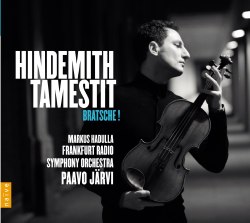| 
|
Paul HINDEMITH (1895-1963)
Sonata for Viola and Piano in F major, Op. 11, No. 4 (1919) [17:38]
Sonata for Solo Viola, Op. 25, No. 1 (1922) [15:41]
Der Schwanendreher (1935) [25:54]
Trauermusik (1936) [7:23]
Antoine Tamestit (viola); Markus Hadulla (piano)
Frankfurt Radio Symphony Orchestra/Paavo Järvi
rec. Hessischer Rundfunk, Sendesaal, Frankfurt, Germany, December 2012, April and September 2013
NAÏVE V 5329 [67:12]
Hindemith’s music for solo violin and viola has received a good deal of attention during the past year, with 2013 being the fiftieth anniversary of his death. Hindemith was a master of the viola and composed very naturally for the instrument. Outstanding among CD releases, at least according to the accolades it received, was the Myrios disc of the music for viola and orchestra with Tabea Zimmermann as soloist. Her recording of the solo and accompanied sonatas is now out, as well. I have had the pleasure of hearing only snippets of Zimmermann’s concerto CD, so I can’t judge this new one by Antoine Tamestit in comparison with Zimmermann. However, I can say that I am greatly impressed with Tamestit’s performances of all the works here.
The CD opens with an early Sonata for Viola and Piano that shows a rather Romantic side of the composer. Indeed, the initial theme reminded me of Brahms. It is a songful work, which gives the lie to the allegation that Hindemith is dry and academic. Written in three movements, played without breaks, it displays the influence of Debussy and even Rachmaninov, in addition to Brahms. Yet it is an attractive and original sonata. Tamestit’s viola has a warm, full-throated sound and Markus Hadulla partners him well. With Tamestit’s wonderfully rich tone and the piano producing real depth, this team seems a perfect match to the music.
It is quite a contrast to turn to the solo sonata coming next on the CD. Hindemith composed it only three years after the earlier work, but it is much more dissonant and astringent. Nonetheless, it is rhythmically interesting and thematically memorable even if its themes do not stick in the mind the way those do from the earlier sonata. The solo sonata has five movements - the first two played without pause - and alternates between short fast sections and longer, more restrained ones. The third movement, for example, is slow and meditative, while the fourth is fast and furious (marked “wild”) and lives up to its designation. The finale begins rather wistfully and later becomes intense, but ends quietly. I have not heard other violists in this music, but Tamestit seems to have all the virtuosity required. His fourth movement is especially riveting.
The remaining works on the CD are undoubtedly familiar to many listeners and represent some of the best of Hindemith at the height of his career. The circumstances that brought about his Trauermusik are well known. In January 1936 Hindemith went to London to give the first performance of his viola concerto, Der Schwanendreher, only to learn the day after he arrived that King George V had died. The BBC then urged him to compose something fitting for the occasion, rather than play the joyful concerto. The composer obliged and in six hours not only finished the work but also learned to play it. Trauermusik is a beautiful, meditative piece for viola and strings, which closes with the chorale, “Vor deinen Thron tret’ich hiermit,” popularly known to English-speaking listeners as “The Old Hundredth”. Tamestit and the Frankfurt Radio Symphony strings contribute a subdued, but eloquent account that compares well with another favourite recording, Geraldine Walther’s (now violist with the Takács Quartet) and the San Francisco Symphony under Herbert Blomstedt.
Der Schwanendreher, or “The Swan-Turner,” is Hindemith’s concerto for viola and small orchestra after old folksongs. Each of the three movements is based on a folksong - the second movement actually has two folksongs representing slow and fast sections, respectively - and the third is a set of variations on the song that gives the work its title. Again Tamestit and Paavo Järvi are up against Walther and Blomstedt in Der Schwanendreher. The former overall are more outgoing than the latter with a greater dynamic range and closer recording. Walther in her less extrovert manner is very sensitive and equally convincing. I like both a great deal, but am really pleased with this new account. Blomstedt is infectious with the sprightly rhythms of the finale, whereas Järvi sets a faster tempo and is a bit heavier. The Frankfurt Radio Symphony’s performance is superb, though, with excellent brass and woodwinds. The sound throughout this recording is also first rate - big with a lot of depth, but clear at the same time. Järvi has turned out to be a fine Hindemith conductor as witnessed here and in his accompaniment with the same orchestra to Frank Peter Zimmermann in the Violin Concerto (BIS), even if he is not as well seasoned as Blomstedt. Tamestit, himself, has the chops necessary to do justice to this music: a big tone and fabulous technique.
The CD booklet includes an interesting interview with Tamestit by Susanne Schaal-Gotthardt, director of the Hindemith Institute of Frankfurt am Main, on Hindemith and his career, but no detailed discussion of the works themselves. There are the usual biographical sketches of the performers.
If you are in the market for a single CD of some of the best of Hindemith’s viola music, then this new disc will not shortchange you in the least. I’m certain I will be listening to it many times again. If, however, you want the complete works for viola, then it might be better to go with Tabea Zimmermann.
Leslie Wright
 |
 |
|
